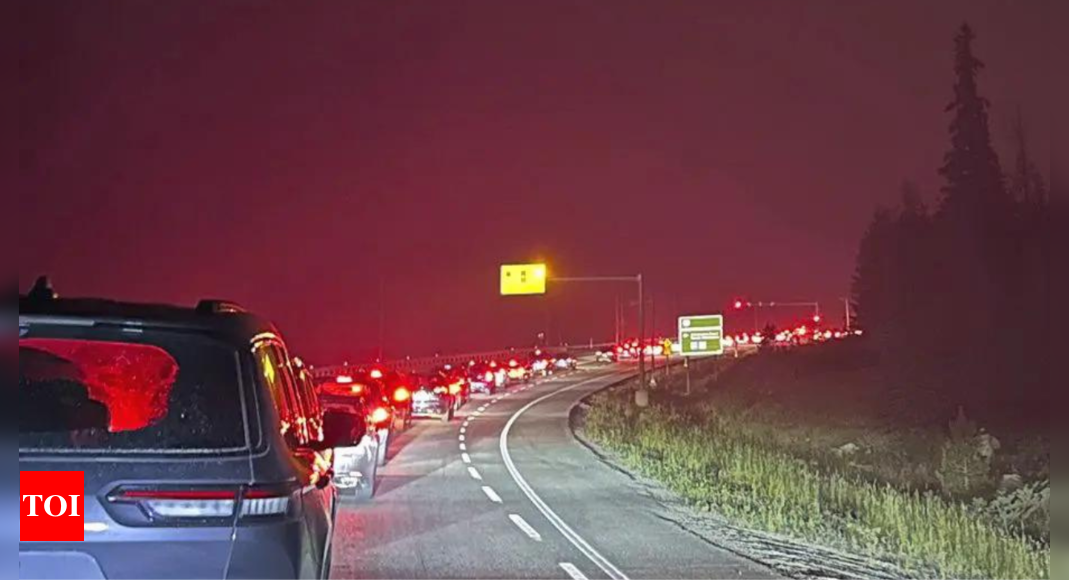
EDMONTON: Multiple wildfires have flared up in the Canadian Rockies‘ largest national park, forcing visitors along with thousands of residents to evacuate and flee west over mountain roads through darkness, soot, and ash, following a government alert. Photos and videos shared on social media overnight Monday through Tuesday showed a midnight cavalcade of bumper-to-bumper cars and trucks, headlights on, red tail lights glowing, cars inching, stopping, starting, crawling through swirling tendrils of acrid smoke, all trying to get out of Jasper National Park and the Jasper townsite – home to 4,700 residents.
The park – situated in the province of Alberta and about 370 km (192 miles) west of the provincial capital city of Edmonton – is popular among tourists and known for its campgrounds and extensive trail networks.
“It’s wall-to-wall traffic,” said Edmonton resident Carolyn Campbell in a phone interview from her vehicle early Tuesday. “(The smoke) is pretty thick. We’ve got masks in the car.”
Campbell said it took hours to move just seven kilometers (about four miles), and while they had enough gas, she was worried for others who fled with little in the tank.
In recent weeks, Alberta has been baking under scorching temperatures, forcing another 7,500 people out in a string of remote communities.
Park and town officials scrambled to clear up traffic gridlock, find fuel for vehicles and help vulnerable people get to safety while marshaling resources to battle the fires.
“Everyone in Jasper must evacuate now,” the Alberta government stated in an emergency alert late Monday night. “Parks Canada is responding to multiple wildfire starts,” the federal agency said in its news release, adding it was “an evolving and dynamic situation.”
Evacuees were told they had five hours to clear out – by 3 a.m. local time Tuesday – and to carry with them key documents, pets, medication and any other emergency supplies. Those without a ride were told to go to the Jasper Activity Centre, Forest Park Hotel or Maligne Lodge.
Travel was not recommended west of the town of Hinton, just east of the national park.
“Please avoid the Jasper National Park area along Highway 16 and allow first responders to do their jobs safely,” the Royal Canadian Mounted Police said in a news release.
Parks Canada – which manages the country’s 48 National Parks – said evacuations had been carried out at numerous campgrounds, as well as the Athabasca Hostel and the Palisades Stewardship and Education Centre.
Fires threatening from the northeast cut off highway access east to Edmonton. Another fire roaring up from the south forced the closure of the north-south Icefields Parkway. That left one route open – west to the neighboring province of British Columbia where officials scrambled to find places for people to stay.
“B.C. will do everything we can to provide safe refuge for evacuees from Jasper, and are working as quickly as possible to co-ordinate routes and arrange host communities on our side of the border,” Bowinn Ma, B.C.’s minister for emergency management, said in a post on the social media site X.
The village of Valemount, just over the B.C.-Alberta boundary, opened its community hall to take in evacuees, with limited space for overnight lodging.
“We are able to give them some water, potentially some snacks,” village CEO Anne Yanciw said. “For those who have been evacuated from their homes, we are able to give them vouchers for a place to stay and vouchers for food.”
More than 160 wildfires were burning across Alberta, coughing up clouds of smoke and obscuring the sky.
A record number of wildfires in 2023 forced more than 235,000 people across Canada to evacuate and sent thick smoke into parts of the US, prompting hazy skies and health advisories in multiple US cities.
The park – situated in the province of Alberta and about 370 km (192 miles) west of the provincial capital city of Edmonton – is popular among tourists and known for its campgrounds and extensive trail networks.
“It’s wall-to-wall traffic,” said Edmonton resident Carolyn Campbell in a phone interview from her vehicle early Tuesday. “(The smoke) is pretty thick. We’ve got masks in the car.”
Campbell said it took hours to move just seven kilometers (about four miles), and while they had enough gas, she was worried for others who fled with little in the tank.
In recent weeks, Alberta has been baking under scorching temperatures, forcing another 7,500 people out in a string of remote communities.
Park and town officials scrambled to clear up traffic gridlock, find fuel for vehicles and help vulnerable people get to safety while marshaling resources to battle the fires.
“Everyone in Jasper must evacuate now,” the Alberta government stated in an emergency alert late Monday night. “Parks Canada is responding to multiple wildfire starts,” the federal agency said in its news release, adding it was “an evolving and dynamic situation.”
Evacuees were told they had five hours to clear out – by 3 a.m. local time Tuesday – and to carry with them key documents, pets, medication and any other emergency supplies. Those without a ride were told to go to the Jasper Activity Centre, Forest Park Hotel or Maligne Lodge.
Travel was not recommended west of the town of Hinton, just east of the national park.
“Please avoid the Jasper National Park area along Highway 16 and allow first responders to do their jobs safely,” the Royal Canadian Mounted Police said in a news release.
Parks Canada – which manages the country’s 48 National Parks – said evacuations had been carried out at numerous campgrounds, as well as the Athabasca Hostel and the Palisades Stewardship and Education Centre.
Fires threatening from the northeast cut off highway access east to Edmonton. Another fire roaring up from the south forced the closure of the north-south Icefields Parkway. That left one route open – west to the neighboring province of British Columbia where officials scrambled to find places for people to stay.
“B.C. will do everything we can to provide safe refuge for evacuees from Jasper, and are working as quickly as possible to co-ordinate routes and arrange host communities on our side of the border,” Bowinn Ma, B.C.’s minister for emergency management, said in a post on the social media site X.
The village of Valemount, just over the B.C.-Alberta boundary, opened its community hall to take in evacuees, with limited space for overnight lodging.
“We are able to give them some water, potentially some snacks,” village CEO Anne Yanciw said. “For those who have been evacuated from their homes, we are able to give them vouchers for a place to stay and vouchers for food.”
More than 160 wildfires were burning across Alberta, coughing up clouds of smoke and obscuring the sky.
A record number of wildfires in 2023 forced more than 235,000 people across Canada to evacuate and sent thick smoke into parts of the US, prompting hazy skies and health advisories in multiple US cities.









